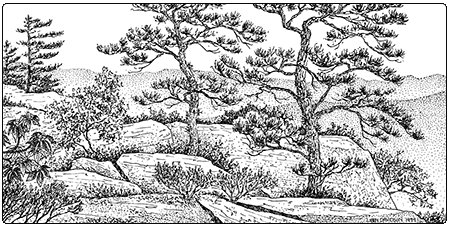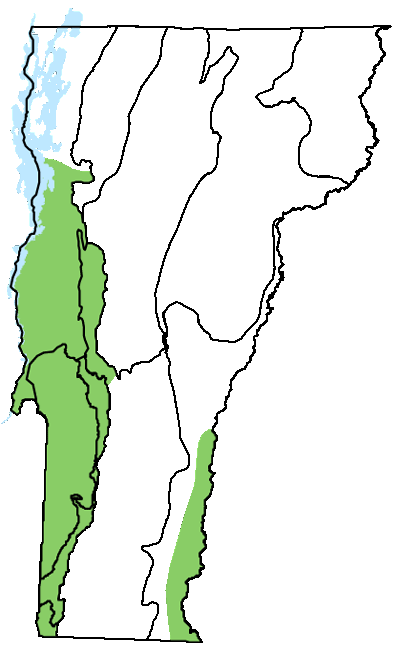Ecology and Physical Setting
Visitors to Pitch Pine-Oak-Heath Rocky Summits are greeted with expansive views through gnarled and stunted pitch pines. Found in southern and western Vermont, these summits show a striking affinity to woodlands found in southern and coastal New England, with their abundance of pitch pine and the occasional appearance of more southern species such as scrub oak and mountain laurel. In other respects, especially in soil conditions and ecological processes, they are very much like Red Pine Forests. Pitch Pine-Oak-Heath Rocky Summits are restricted to dry, open, rocky ridges on acidic bedrock, in the warmer climate areas of the state. Fire plays an important role in maintaining these communities, and dry, shallow soils keep many hardwood species from becoming established.
Vegetation
This community is a true woodland, with a canopy cover of less than 60 percent and often closer to 30 percent. Trees are scattered and low growing. Pitch pine is the most common tree. Red and white pine can be common as well, along with oaks and red maple. The ground layer is often very sparse, consisting of low grasses and forbs along with scattered low shrubs. Overall species diversity is very low, with heath shrubs dominating.
 Pitch pine reaches its northern range limit in Vermont and is restricted almost exclusively here to Pitch Pine-Oak-Heath Rocky Summits and to Dry Pine-Oak-Heath Sandplain Forest. It is a fire-adapted tree, with heat-resistant bark, seeds that germinate well on mineral soil rather than organic soil, and cones that open when subjected to heat. It is also a drought-tolerant tree. This combination of attributes makes it successful in this community.
Pitch pine reaches its northern range limit in Vermont and is restricted almost exclusively here to Pitch Pine-Oak-Heath Rocky Summits and to Dry Pine-Oak-Heath Sandplain Forest. It is a fire-adapted tree, with heat-resistant bark, seeds that germinate well on mineral soil rather than organic soil, and cones that open when subjected to heat. It is also a drought-tolerant tree. This combination of attributes makes it successful in this community.
Wildlife Habitat
These exposed, hot, dry, woodlands are typically very small and provide habitat diversity for the wildlife species that use adjacent forests. But in larger examples of Pitch Pine-Oak-Heath Rocky Summit, such as on Black Mountain in Dummerston, several species of birds that are characteristic of shrubby habitat are found. The “drink your tea” call of an eastern towhee is a welcome greeting when emerging from the forest onto the Black Mountain summit. Other nesting birds include brown thrasher, Nashville warbler, and chipping sparrow. Pine warblers are attracted to the taller pitch and white pines that occur in some examples of this community. Towhees are often associated with old fields, managed shrublands, and power line rights-of-way, but Pitch Pine-Oak-Heath Rocky Summit is one of only a few natural habitats for this species in Vermont. The Carolina andrena bee is a pollen specialist relying on heath-family species, especially blueberries and huckleberries, which are common in this community. The brown elfin is an uncommon butterfly that also uses heath species as host plants and is found on Black Mountain.
Successional Trends
This community is maintained by occasional fires that keep some deciduous trees from becoming prominent. In the absence of fire, leaf litter can accumulate and allow hardwood species to replace pitch pine.
Related Communities
- Red Pine Forest is similar ecologically but is more northern in character and rarely has pitch pine.
Conservation Status and Management Considerations
This is a fire-adapted community, so natural fires should be allowed to burn on hilltops where this community occurs. More intense summer droughts may favor this community by increasing the incidence of fire and reducing competition from hardwoods.
Distribution/Abundance
Rare statewide; known only from southern Vermont, and the southern Champlain Valley and adjacent mountain ridges.
Characteristic Plants
Trees
Abundant Species
Pitch pine – Pinus rigida
White pine – Pinus strobus
Red pine – Pinus resinosa
Red oak – Quercus rubra
Red maple – Acer rubrum
Occasional to Locally Abundant Species
Eastern hemlock – Tsuga canadensis
Paper birch – Betula papyrifera
Gray birch – Betula populifolia
Black oak – Quercus velutina
Scrub oak – Quercus ilicifolia
American beech – Fagus grandifolia
White oak – Quercus alba
Chestnut oak – Quercus montana
Shrubs
Abundant Species
Low sweet blueberry – Vaccinium angustifolium
Huckleberry – Gaylussacia baccata
Occasional to Locally Abundant Species
Witch hazel – Hamamelis virginiana
Black chokeberry – Aronia melanocarpa
Low red shadbush – Amelanchier sanguinea
Mountain laurel – Kalmia latifolia
Herbs
Abundant Species
Poverty grass – Danthonia spicata
Occasional to Locally Abundant Species
Canada mayflower – Maianthemum canadense
Starflower – Lysimachia borealis
Sarsaparilla – Aralia nudicaulis
Hairgrass – Deschampsia flexuosa
Wintergreen – Gaultheria procumbens
Rare and Uncommon Plants

dry, and shallow soils of Pitch Pine-Oak-Heath Rocky Summits.
Scrub oak – Quercus ilicifolia
Mountain laurel – Kalmia latifolia
Clustered sedge – Carex cumulata
Associated Animals
Eastern towhee – Pipilo erythrophthalmus
Brown thrasher – Toxostoma rufum
Nashville warbler – Oreothlypis ruficapilla
Pine warbler – Dendroica pinus
Chipping sparrow – Spizella passerina
Carolina andrena bee – Andrena carolina
Rare and Uncommon Animals
Brown elfin – Callophrys augustinus
Places to Visit
Black Mountain Natural Area, Dummerston. The Nature Conservancy
